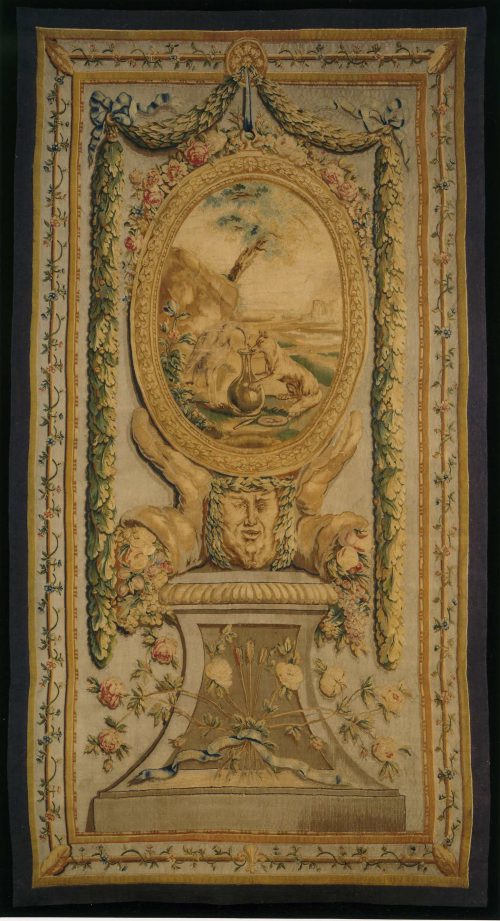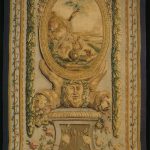8066 A PAIR OF SILK LOUIS XVI ENTRE-FENÊTRES DEPICTING SCENES FROM AESOP’S FABLES Beauvais Or Aubusson. Circa 1775. Measurements: Height: 93.3″ (237 cm) Width: 48″ (122 cm)

Research
Of woven colored silk and metal thread. Each with meandering foliate border enclosing a waisted pedestal on which rests spilling cornucopia supporting an oval framed vignette depicting a scene from Aesop’s fables and surmounted by heavy floral swags.
The present tapestries each illustrate a scene from one of the well-known moral allegories known as Aesop’s fables. One shows the ending of “The Fox and the Stork,” in which the stork repays her friend in kind for his poor hosting of the dinner they shared the day before. Unable to drink out of the stork’s tall vase, the fox regrets his joke of serving the stork soup in a shallow bowl, and apologizes for his bad manners. The second tapestry shows the story of “The Wolf and the Crane.” The crane, in expectation of some great reward, trustingly sticks his head into the wolf’s mouth in order to dislodge a bone stuck in the wolf’s throat. Having successfully withdrawn the bone, he finds that his reward is simply to have kept his head.
Written versions of Aesop’s fables date from the 3rd century AD, and have been handed down over the centuries as cautionary morality stories. The tales in the present tapestries were two of the most popular of all the fables, and “among the most often reproduced images from Aesop’s fables are those relating to ‘The Fox and the Stork’,”1 depicted “on vases and tombstones from Ur to Rome…”2
One of earliest representations of Aesop’s fables on textiles is found in the Bayeux tapestry, a 12th century tapestry depicting the Norman invasion of England which is bordered by images from Aesop’s tale “The Fox and the Crow.” Beginning in the 15th century, with the invention of the printing press, illustrated versions of the fables were being produced. From these collections, decorative objects such as manuscripts, ceramics, hanging tapestries, and seat furniture were designed using the printed engravings. Between 1729 and 1735, Jean-Baptiste Oudry produced a series of drawings for Beauvais tapestry manufacture based on Jean de la Fontaine’s version of the fables. They were woven over a dozen times by Beauvais and subsequently picked up by Aubusson.
The design of the present tapestries is notable as the fable is not resigned to a small central cartouche, like those of Beauvais, nor does it fill the entire surface of the tapestry panel. The elaborate alentours are as detailed and decorative as the scenes they encircle.
Footnotes:
1. Grigsby, Leslie B. “Aesop’s Fables on English Ceramics.” The Magazine Antiques. June 1994: 868-77.
2. ibid., No. 4.

Comments are closed.